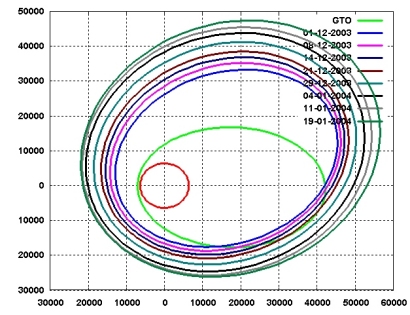No. 16 - Ready for payload commissioning
The total cumulated thrust so far of more than 1600 hours, consuming 25.7 kg of Xenon, has provided a velocity increment of about 1150 ms-1 (equivalent to 4140 km per hour). This week the electric propulsion engine's performance, periodically monitored by means of the telemetry data transmitted by the spacecraft and by radio-tracking by the ground stations, has been nominal.
The SMART-1 Science and Technology Working Team (STWT20) met at ESOC on the 15 January 2004. The main objectives were to give the status of the payload (PL) commissioning and plan future activities. Present at the meeting were instrument Principal Investigators (PIs), Technology Investigators (TIs), Flight Control Teams from ESOC and representatives of the Flight Dynamics Group. This unique combination of resources presented much useful information for the planning of the coming activities. The Flight Dynamics Group presented a thrusting strategy for the coming months, which will drive both the commissioning-calibration and cruise phases.
The plasma diagnostic experiments, EPDP and SPEDE, have been operational since the first week of the mission and have measured the spacecraft environment during both periods of electric thrust and no thrust. These early results were discussed at a workshop held at ESTEC on 20 January. On the morning of Sunday 18 January, the AMIE camera took its first test image of a crescent Moon. This image will be included in a later status report.
From 1 February to 22 February 2004, the electric propulsion (EP) will cease. The resulting stable, defined, spacecraft orbit is ideal for payload commissioning and targeted pointings. The AMIE camera will acquire images from a series of targets, and the SIR infrared and D-CIXS X-ray spectrometers will obtain their first spectra.
During March, there will be a period of EP thrusting and long eclipses, which will limit the payload to simple operations at apogee. Once this period has finished, normal operations can resume and an extended commissioning and cruise science phase will operate from April-June during the coast arcs.
A series of lunar resonance gravity assists will take place on 20 August, 16 September and 14 October. The STWT20 agreed to have only one lunar swingby, on or around 9 November, before lunar capture takes place in early December. After capture and down spiral, the xenon fuel reserves will lower the apolune to the final science orbit.
Orbital/Trajectory information
The ESOC specialists periodically compute the osculating orbital elements. These elements define the so-called "osculating orbit" which would be travelled by the spacecraft if at that instant all perturbations, including EP thrust, would cease. Therefore, it is an image of the situation at that epoch. In reality, the path travelled by the spacecraft is a continuous spiral leading from one orbit to another. The most recent osculating elements are as follows:
|
EPOCH (UTC) 2004/01/19 01:03:30.6 Elements WRT Earth (J2000) |
|
| Pericentre Distance (km) |
20 364.598800 |
| Apocentre Distance (km) |
61 034.844212 |
| Semi Major Axis (km) |
40 699.721506 |
| Eccentricity |
0.499638 |
| Inclination (deg) |
6.871803 |
| Asc. Node (deg) |
150.379374 |
| Arg. of Pericentre (deg) |
211.553750 |
| True Anomaly (deg) |
180.262376 |
| Osc. Orbital Period (h) |
22.698421 |
The osculating orbits at launch (GTO) and at different times are shown in the plot. From the start, the electric propulsion system has increased the semi-major axis of the orbit by 16 170 km, increasing the perigee altitude from the original 656 km to 13 986 km, the apogee altitude from the original 35 844 km to 54 657 km and the orbital period from the initial 10 hours 41 minutes to the present 22 hours and 41 minutes.
 |
|
SMART-1 osculating orbit up to 19 January 2004 |
Contact Points
Giuseppe Racca
SMART-1 Project Manager
ESA/ESTEC - SCI-PD
Keplerlaan 1- 2200 AG Noordwijk, The Netherlands
E-mail: Giuseppe.Racca esa.int
esa.int
Bernard H. Foing
SMART-1 Project Scientist
ESA/ESTEC - SCI-SR
Keplerlaan 1- 2200 AG Noordwijk, The Netherlands
E-mail: Bernard.Foing esa.int
esa.int

